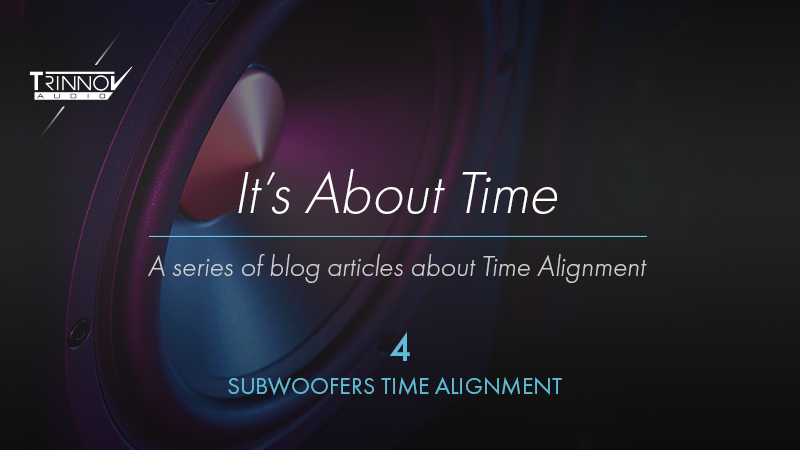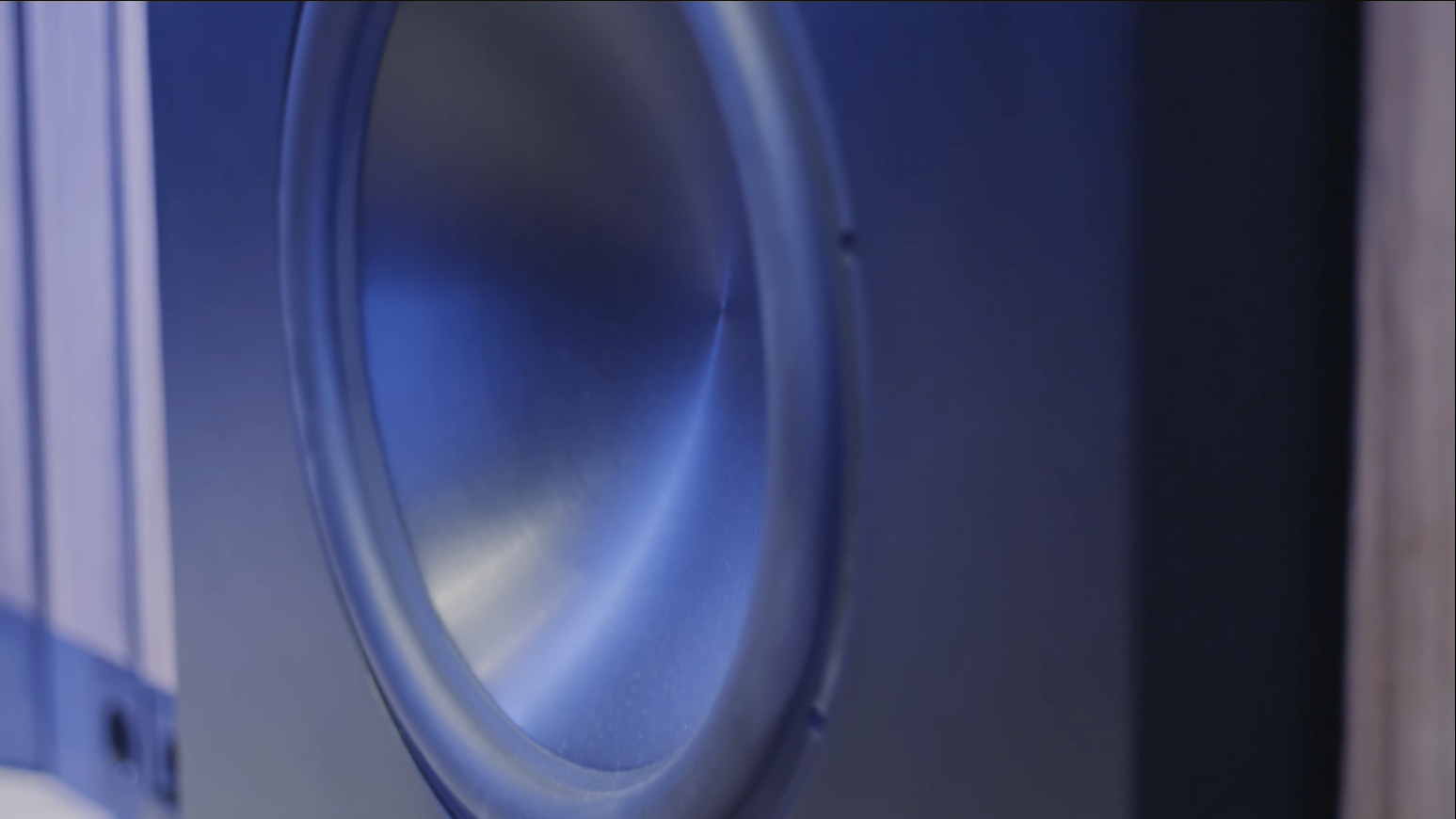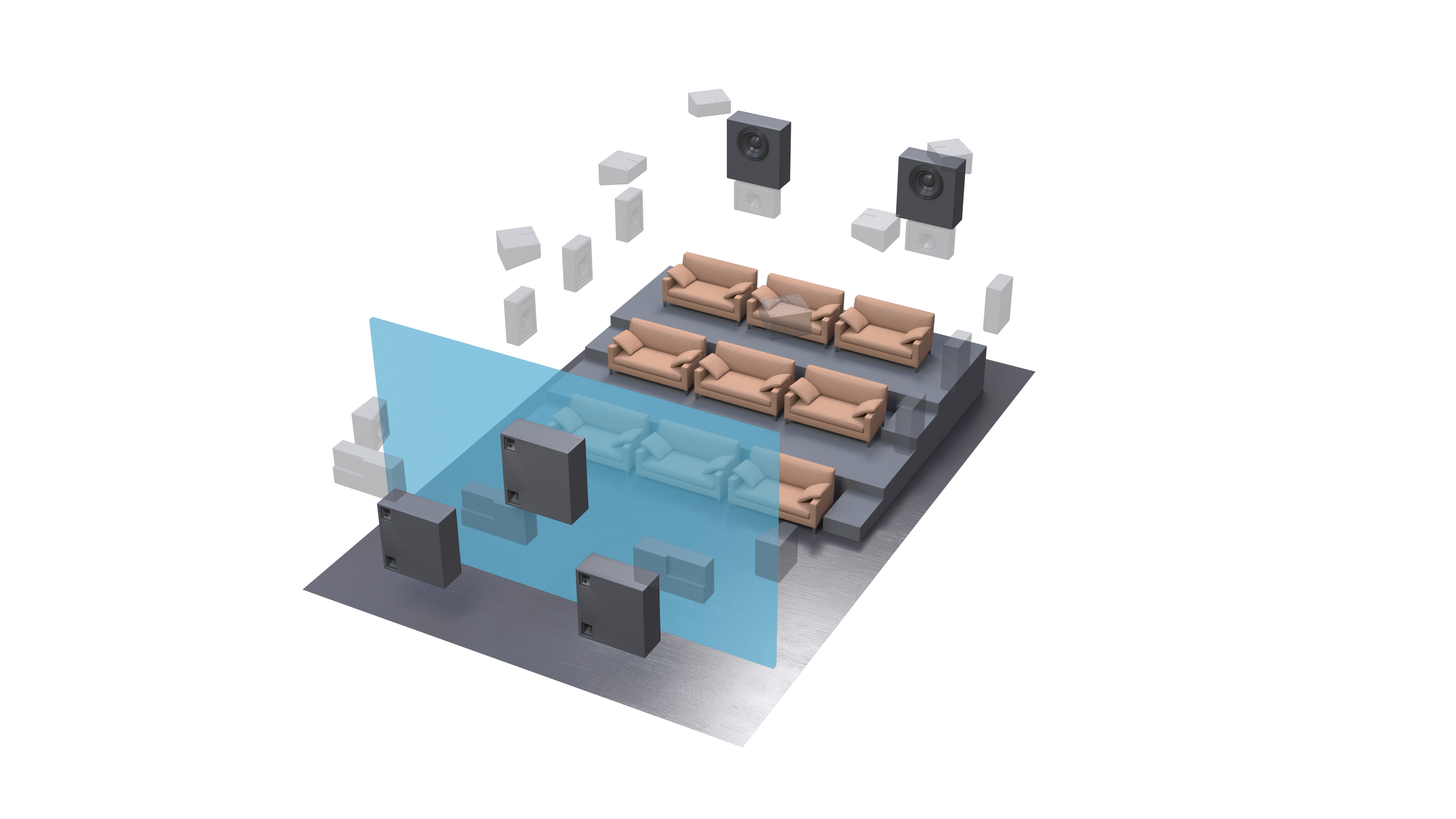It's About Time #4: Subwoofers Time Alignment
A series of blog articles about Time Alignment
7 May 2024
Technical Articles

The previous It's About Time articles covered two essential concepts in time alignment: speaker alignment and driver alignment. Let's now focus on how introducing subwoofers to the speaker layout influences time alignment. In addition, we will also cover different methods for integrating multiple subwoofers into a system to achieve a more consistent response across a larger listening area.
Integrating subwoofers with speakers
You might imagine that all you have to do with subwoofers is to time-align them to compensate for their distances from the Main Listening Position (MLP), just like all the other speakers in the system.
In reality, getting these deep-bass speakers to integrate smoothly and seamlessly with the main speakers is a bit more difficult. Speaker designers work long and hard to make sure that the handoff from the woofer to the midrange is smooth and undistorted. Done correctly, the challenge involves the characteristics of the drivers themselves, the physical spacing of drivers from one another, and the design of the crossover.
Even in this scenario, in which the designer has control over all aspects of the speaker itself (the selected drivers, their spacing, and the crossover design), getting a seamless handoff from one to the next can be difficult. Imagine how much more difficult it would be if the designer had no idea what woofer would be used and where the woofer would be placed. This is the situation when it comes to the integration of a subwoofer with the main speakers.
In the video below, Rene Verdult and Micha Heyboer from Black Sun Empire explain the challenges they faced in their studio when trying to integrate a subwoofer with satellite speakers.
Room accoustics & subwoofers
As if that wasn’t enough, room acoustics dominate the performance of subwoofers in typically-sized residential spaces. Contrary to the perception that “bass is omnidirectional, so you can put the subwoofer anywhere,” placement of the subwoofers is actually critical to maximizing their performance.
This is partly because some of the wavelengths of these low frequencies will match various dimensions of the room itself such that the reflection of the sound between two walls either reinforces or cancels out particular frequencies. These frequencies are therefore either “amplified” or largely canceled out by the room itself, resulting in uneven bass that has little to do with the speaker itself.
These differences are not subtle: the response variations introduced by the room itself can be 20 dB or more from the least loud to the loudest frequencies. (A change of 20dB louder sounds about four times as loud and normally would require one hundred times as much power from the amplifier – but, in this case, the room itself is causing the differences.)
These variations depend on the room's dimensions, which is why different rooms behave differently at the same frequency. This is why they are called "Room Modes",

Experiencing Room Modes
If you want to prove to yourself that this has a real and dramatic effect on the performance of your system at low frequencies, try this simple experiment:
-
With just a single subwoofer placed in one corner of the room, find some sine wave test tones on a disc (or on an app from your computer or phone) that you can play on your system. (To keep things simple, just use one sub. If you have multiple subs, turn the others off for now.)
-
Play a pure tone (a simple sine wave) at some frequency between 40 to 80 Hz. Any frequency will do for now – we are just looking for a frequency that is comfortably within your subwoofer’s range of frequencies.
-
Starting in one corner of the room, slowly walk along the length of the room, paying attention to how loud the test tone seems. It will vary much more than most people would have imagined.
-
Repeat this same slow walk at 90° to the previous path across the length rather than along it. Again, things will change quite dramatically.
Repeat these simple steps with a few different bass frequencies to get a better demonstration of just how dramatically your system is affected by the relationship between a) the room dimensions, b) the subwoofer’s placement within the room, and c) the listener’s location within the room.
If you want something even more dramatic, measure the length of your room and then divide the speed of sound by that measurement. (The speed of sound is 1130 feet, or 343 meters, per second.) For example, 343 meters per second, divided by a 7-meter long room, results in a frequency of 49 Hz (meaning, a 49 Hz sound wave will fit perfectly in a 7-meter long room).
Repeat steps 1-4 above with whatever frequency corresponds to the length or width of your room. You will find that there are some places in the room that are quite loud and others where the sound almost completely disappears.
Placement and calibration of multiple subs
You may have heard that multiple subwoofers can result in smoother, more accurate bass. As we just saw, the room itself will alter the frequency response of even a “perfect” sub quite dramatically (and differently) depending on where it and the listener are in the room.
The idea behind using multiple subs can be thought of this way: since the room introduces hills and valleys in that response curve, having multiple subs and getting them properly placed and time-aligned can allow one sub’s “hills and valleys” to be mitigated by another sub’s “valleys and hills,” resulting in more consistent bass in more areas of the room (there is more to it than this, but you get the idea).
There are a few schools of thought as to the “best” way to configure and calibrate your subwoofers. In the Altitude, we aim to support all of these approaches, and more with our own, unique WaveForming technology described further in this article.
A thorough treatment of fully optimizing the bass performance in your room is beyond the scope of this article. Entire doctoral theses have been written on the subject.
But, for now, I hope that you understand that you can create smoother, more consistent bass in the room through careful placement and calibration of multiple subs.
Let's take a look at a well known manual time alignment technique.
A Technique for Aligning Subwoofer Arrays
One method for achieving smooth, impactful bass involves a multi-step process of optimizing the way the subs work with each other and then optimizing how the entire array of subwoofers is integrated into the rest of the system.
-
Start with four subs placed either in the four corners of the room, or at the ¼ and ¾ points along opposite walls. (Both arrangements work well in most rooms.) They will be called Subs 1, 2, 3, and 4 – any order will do as long as you are consistent.
-
Using REW or a similar acoustic measurement tool, measure the response of Sub 1 and of Sub 2, individually. Then measure the response of Sub1 + Sub 2 (playing together).
-
Ideally, the Sub 1+2 curve should be at least somewhat (2 dB or so) louder than either Sub 1 or Sub 2 at all its relevant frequencies. In most cases, this will not be true because the two subs will be reinforcing each other at some frequencies (good) but working against each other at other frequencies (bad). Don’t worry about flat response at this stage, just focus on whether or not the combined response is greater than the individual response curves.
-
Experiment with adding small amounts of delay to one of the subs until the combined response is at least a bit greater than the individual curves across the range (for example, from 20 - 80 Hz).
-
Once Subs 1+2 are optimized to work well together in this way, treat them as though they were a single subwoofer and repeat Steps 2-4 with Sub 3.
-
Once Subs 1+2+3 are working well together across the range, repeat the process with Sub 4.
-
Once all the subs combined are consistently producing more bass at all the relevant frequencies together rather than individually, treat all four subs as a single array of subs (which they now are). You can now EQ them to the desired response in your room, across the seating area.
The last step can be done manually with PEQ or automatically by room correction software (the Altitude supports either approach, as well as using both.)
Another feature found on the Altitude is the Pulse test signal, which can be used for fine-tuning the time alignment between subs and the main screen channels.
This is important because it is inherently more difficult to accurately time-align bass frequencies since they, by definition, move slowly as compared to mids and highs. After all, a single sine wave at 50 Hz lasts a full 20 ms, whereas the same single wave at 5000 Hz exists for only 0.2 ms.
The Pulse signal repeats an extremely short, positive pulse that stimulates all the chosen speakers:

In this example, we are applying the Pulse to the Center channel and the LFE (which is normally routed to the subwoofer). With a little practice, it is relatively easy to fine-tune the time alignment of the subs to the most important speakers in the system (the screen channels).
When listening to the Pulse signal across these speakers, you want to “center” the higher-frequency portion of the pulse within the lower-frequency “thump” coming from the subs.
If the screen channels are leading the subs by a little bit, the Pulse signal will sound like it is going down in pitch (meaning, the sub’s output is trailing the screen channels by a small amount); conversely, if the Pulse sounds like it is going up in pitch, the subs are leading the mains and needs to be delayed slightly.
For those who are more visually oriented, you are listening for clicks that might be “leaning” one way or the other as shown below.

Centering the higher-frequency portion of the pulse within the lower-frequency
The reason we see (and hear) something akin to a bell-shaped curve is that woofers respond more slowly to an impulse than do tweeters. It simply takes them longer to complete one full cycle at lower frequencies than at higher frequencies.
Note that there are many different approaches to maximizing the performance of low frequencies in “small” rooms (meaning, typical for a home as opposed to a large concert venue). The inter-subwoofer alignment and the Pulse alignment techniques are just small aspects of the sound that, when done correctly, can greatly enhance the impact of the deep bass.
The fact that one needs to follow a process like this one illustrates some of the challenges presented by the room’s acoustics at those frequencies.
Thankfully, after focusing our research efforts on this challenge, we now have a far better, efficient and simple solution.
Introducing WaveForming
The introduction of our patented WaveForming technology dramatically changes the way one perceives low frequency reproduction.
If you have read this far, you now understand subwoofer placement in a room is as critical as how subwoofers are aligned together and with the main speakers.
WaveForming is designed as a holistic solution which combines recommended subwoofer placement and advanced time/frequency processing. This truly sets Trinnov apart from competition and results in increased performance, greater predictability with a simplified, automated calibration process.

A possible subwoofer placement to leverage WaveForming
Another fundamental difference of WaveForming is that instead of having multiple subwoofers playing against each other at some frequencies to achieve a smoother bass response, WaveForming drives the multiple subwoofers in the room so that they all contribute together to the same goal, as a single, intelligent subwoofer.
In terms of time aligmnent, WaveForming performs multiple steps of calculations to effectively:
-
Time align subwoofers within each subwoofer array (WaveForming requires both a front, and a rear array of subwoofers):
-
Ensures a consistant wave front coming from the screen and optimal propagation to the back of the room
-
Optimizes bass propagation based on the room's characteristics to avoid excessive reflections against the floor, ceiling and side walls (fixing the source of the problem rather than mitigiating its impact) using room-matched bass steering
-
Ensures rear subs are also time aligned together
-
-
Time align the front and rear array together to make sure the rear array of subwoofer timely "catches" the wavefront to cancel the remaining reflections
This is a simplified explanation what WaveForming does but I can add that in addition to the above, such time alignment is also frequency-dependant.
Key takeaways
The main idea of this article is that you can create smoother, more consistent bass in the room through careful placement and calibration of multiple subs.
Room accoustics and dimensions have a high impact on the performance of subwoofers such that the reflection of the sound between two walls either reinforces or cancels out particular frequencies.
Having multiple subs and getting them properly placed and time-aligned can allow one sub to be mitigated by another sub resulting in more consistent bass in more areas of the room.
We believe that time aligning all subwoofers is the right place to start but that newer, more advanced approaches such as WaveForming represent significant breakthroughs, achieving results with intelligent analysis and algorithms that are impossible to achieve manually.
Related articles:
|
It's About Time Series #1: Introduction |
It's About Time #5: Impulse Response (coming soon)

